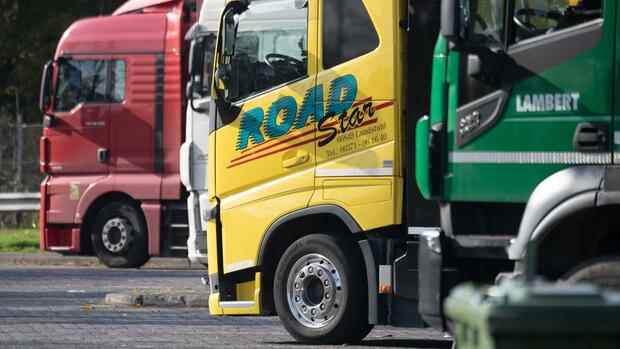Warsaw Ukraine, attacked by the Russian army, is the poorest country in Europe. And so it is hardly surprising that the residents do some work that hardly anyone on the continent wants to do: for example, driving international trucks.
Just how important the Ukrainians are for the industry can be seen in Poland. Around five weeks after the outbreak of war, the transport sector there is in a state of excitement. Around 300,000 drivers work for Polish logistics companies in international transport. According to the Polish industry association ZMPD, around 110,000 of them are Ukrainians, more than a third of whom are currently not working.
Instead, they are involuntarily stuck in their homes or engaged in some form of defense. ZMPD spokeswoman Anna Brzezinska is alarmed: “Trucks are parked in the transport hubs because there are few drivers.” To make matters worse, the Polish transport companies also lack drivers from Belarus. According to the association, around 30,000 people from the neighboring country are employed by Polish transport companies.
Their continued employment also hangs in the balance. They have to return home regularly to extend their visas. However, many drivers are currently reluctant to cross the border. They fear being drafted into the army if the war spreads.
Top jobs of the day
Find the best jobs now and
be notified by email.
Poland’s transport companies, which are a heavyweight in Europe’s logistics sector thanks to relatively cheap Ukrainian and Belarusian drivers, now fear rising wages. On the other hand, it is rather unlikely that the freight tariffs can be increased, says Brzezinska. “Logistics companies’ profits are falling, and many of them were already in a bad financial position.” The leasing companies, which often own the trucks, would not grant payment deferrals, says the industry representative.
The war in Ukraine is putting a spotlight on a sector that has previously struggled with driver shortages. A survey by the international industry association World Road Transport Organization (IRU) showed that around 20 percent of jobs in Eurasia were vacant in 2020.
Rough environment deters
Far too few young school leavers decide to become long-distance drivers to replace the truckers who are about to retire. The reasons for this are diverse. In many countries, driving a truck is only allowed at the age of 21. However, potential junior employees often leave school at around the age of 16 and are thus lost to the transport industry.
The IRU also complains about the harsh environment in which truck drivers work. IRU spokesman John Kidd criticizes: “Long-distance drivers are often treated with too little respect, for example at customs or when unloading.”
The drivers also work long hours and are sometimes not at home for weeks. In addition, almost everywhere in Europe there is a lack of safe places to rest, says Kidd. “We would like to see more investments there.”
>>Read here: Imminent supply bottleneck – in Germany alone there is currently a shortage of 60,000 to 80,000 truck drivers
Like other industries, logisticians would like to employ more women. But the working conditions are even more of a deterrent to them. There are therefore hardly any women who work as long-distance drivers. According to the IRU, their share is even falling.
Many drivers from Belarus are afraid of being conscripted at home.
(Photo: dpa)
Previously, Polish logistic companies relied primarily on local drivers. But with increasing prosperity, the long-distance driver’s profession became less attractive – as had happened before in Western Europe. And, according to association representative Brzezinska, wanderlust is no longer a motive for becoming a truck driver.
On average, Poles are now so wealthy that private trips abroad are financially feasible. Nobody needs to drive a truck to see Western Europe anymore. The poorer neighbors, the Ukrainians, therefore jumped into the gap.
It is striking that many of them work in another transport industry, which is unpopular in Western Europe due to the difficult working conditions. According to the Association of German Shipowners (VDR), from a global perspective, almost four percent of all seafarers are Ukrainians.
>>Read here: Delivery routes to Russia are collapsing – ships are backing up in Europe’s ports
With the war at home, an explosive situation has arisen. There are also many Russians among the seafarers, according to the VDR their share is around ten percent. Around 5,000 seafarers from Russia and Ukraine work on German merchant ships, some of them on the same vessel. VDR spokesman Christian Denso warns: “The longer the war in Ukraine lasts, the more difficult this situation becomes.”
The shipowners fear that tensions could be discharged on the ships. “We may have to consider separating crews,” says Denso. As with long-distance drivers, among seafarers there is also the fact that many Ukrainians are stuck in their homeland or would like to return there as quickly as possible to protect their families.
Shipowners will therefore probably have to turn to other labor markets, such as the Philippines. Many sailors are already coming from there.
Road transport companies have a harder time there. Western Europe’s logisticians have pushed further and further east to recruit cheap drivers: first to Central Europe, then to the Balkans and Ukraine. In the east of Ukraine lies Russia.
More: The fear of supply bottlenecks is growing
